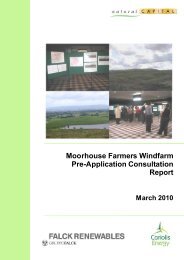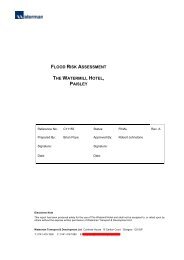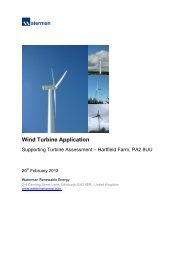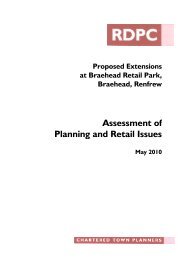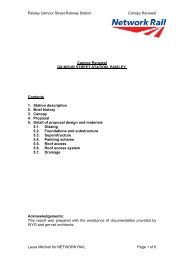GLENLORA WIND TURBINE - Renfrewshire Council
GLENLORA WIND TURBINE - Renfrewshire Council
GLENLORA WIND TURBINE - Renfrewshire Council
Create successful ePaper yourself
Turn your PDF publications into a flip-book with our unique Google optimized e-Paper software.
<strong>GLENLORA</strong> <strong>WIND</strong> <strong>TURBINE</strong><br />
in line with Policy REN1 of the <strong>Renfrewshire</strong> Local Plan which is generally supportive<br />
of an increase in the proportion of electricity produced from renewable sources.<br />
Access<br />
It is intended that the turbines would be landed at Grangemouth, transported<br />
southwest via the A904, M9, M876, M80, M8 and onto the A737. The route then<br />
takes the 2 nd exit at Roadhead Junction on the A760. The route then turns west onto<br />
Corsefield Road and enters the Glenlora Estate via an access track located on the<br />
eastern side of Glenlora House. A level of minor road works with minimum removal<br />
of trees and hedgerows is anticipated.<br />
Access Tracks & Crane Hard-standing<br />
Construction of site tracks will utilise stone brought in from a nearby quarry. In<br />
addition to the site tracks themselves, a temporary working area of 450m 2 (30m by<br />
15m) would be required at the wind turbine position. This area is additional to one<br />
area of hardstanding (30m by 20m) to support the cranes (including outriggers) used<br />
for the erection of the wind turbine. The precise shape of the temporary working<br />
area will be refined to reflect construction and environmental factors at the turbine<br />
location. The construction of these areas of hardstanding will be similar to the<br />
construction of site tracks.<br />
Reinstatement of the track verges and the areas of hardstanding would be<br />
undertaken following construction. As there would be a continuing need to use the<br />
site tracks, the tracks will be left in place for the duration of the project.<br />
Running surfaces would be suitably profiled to reduce surface drainage flows. Any<br />
surface water drainage for the tracks and hardstanding will be designed to comply<br />
with the principals of Sustainable Drainage Systems (SuDS).<br />
Foundation<br />
The wind turbine requires foundations which are covered by topsoil when<br />
construction is complete, leaving a plinth of about 5.5m in diameter at the surface<br />
level upon which the turbine would be bolted. The foundation would require an<br />
excavation with a diameter of up to 18m and a depth of 1.7m. The foundation<br />
would typically have a diameter of up to 16m, giving an additional meter all around<br />
to allow shuttering access, with the shuttering positioned and supported. The<br />
foundation would comprise up to 170 cubic metres of concrete and 17 tonnes of<br />
reinforced steel bar.<br />
Cable Runs<br />
The wind turbines envisaged for use on this site produce electricity at 400 volts. This<br />
would be transformed to 11kV using a transformer adjacent to the turbine. From<br />
the transformer, underground cable runs will link the turbine to a substation<br />
© Green Cat Renewables Ltd<br />
Z:\projects\C0111-080 Glenlora\Planning\NTS\Glenlora NTS.doc<br />
Page 12 of 25



